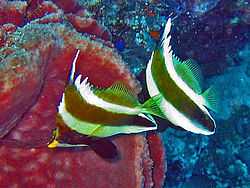Heniochus chrysostomus
| Heniochus chrysostomus | |
|---|---|
 | |
| Heniochus chrysostomus from Borneo | |
| Conservation status | |
| Scientific classification | |
| Kingdom: | Animalia |
| Phylum: | Chordata |
| Class: | Actinopterygii |
| Order: | Perciformes |
| Family: | Chaetodontidae |
| Genus: | Heniochus |
| Species: | H. chrysostomus |
| Binomial name | |
| Heniochus chrysostomus G. Cuvier, 1831 | |
| Synonyms | |
| |
Heniochus chrysostomus, common name Threeband pennantfish, is a tropical fish of the family Chaetodontidae.
Description
Heniochus chrysostomus can attain a maximum length of 18 centimetres (7.1 in) in males. The body is oval, laterally flattened, with a basic white color and three broad oblique brown bands. The first band runs from the forehead up to the pelvic fins, the second from the dorsal fin to the anal fin, the third is adjacent to the dorsal fin. The dorsal fin is elongated, in juveniles much more than in adults. Juvenile fishes are solitary. The snout tip is yellow. This species is oviparous and feeds on coral polyps.
Fins formula: Dorsal XII-XIII/21-22, Anal 17-18.
.jpg)
Distribution
This species has an Indo-Pacific distribution, from Western India to Pitcairn Islands, Japan, southern Queensland, Micronesia and New Caledonia.
Habitat
Threeband pennantfish typically inhabits coral-rich areas of reef flats, lagoon and seaward reefs at a depth of 2–40 metres (6 ft 7 in–131 ft 3 in). Juveniles are usually found in lagoons and estuaries.[1]
References
- ↑ Dianne J. Bray, 2011, Pennant Bannerfish, Heniochus chrysostomus, in Fishes of Australia, accessed 26 Sep 2014, http://www.fishesofaustralia.net.au/home/species/2411
- Eric Parmentier1, Kelly S. Boyle, Laetitia Berten, Christophe Brié and David Lecchini Sound production and mechanism in Heniochus chrysostomus
- Fish Base
- Biolib
- Discover Life
